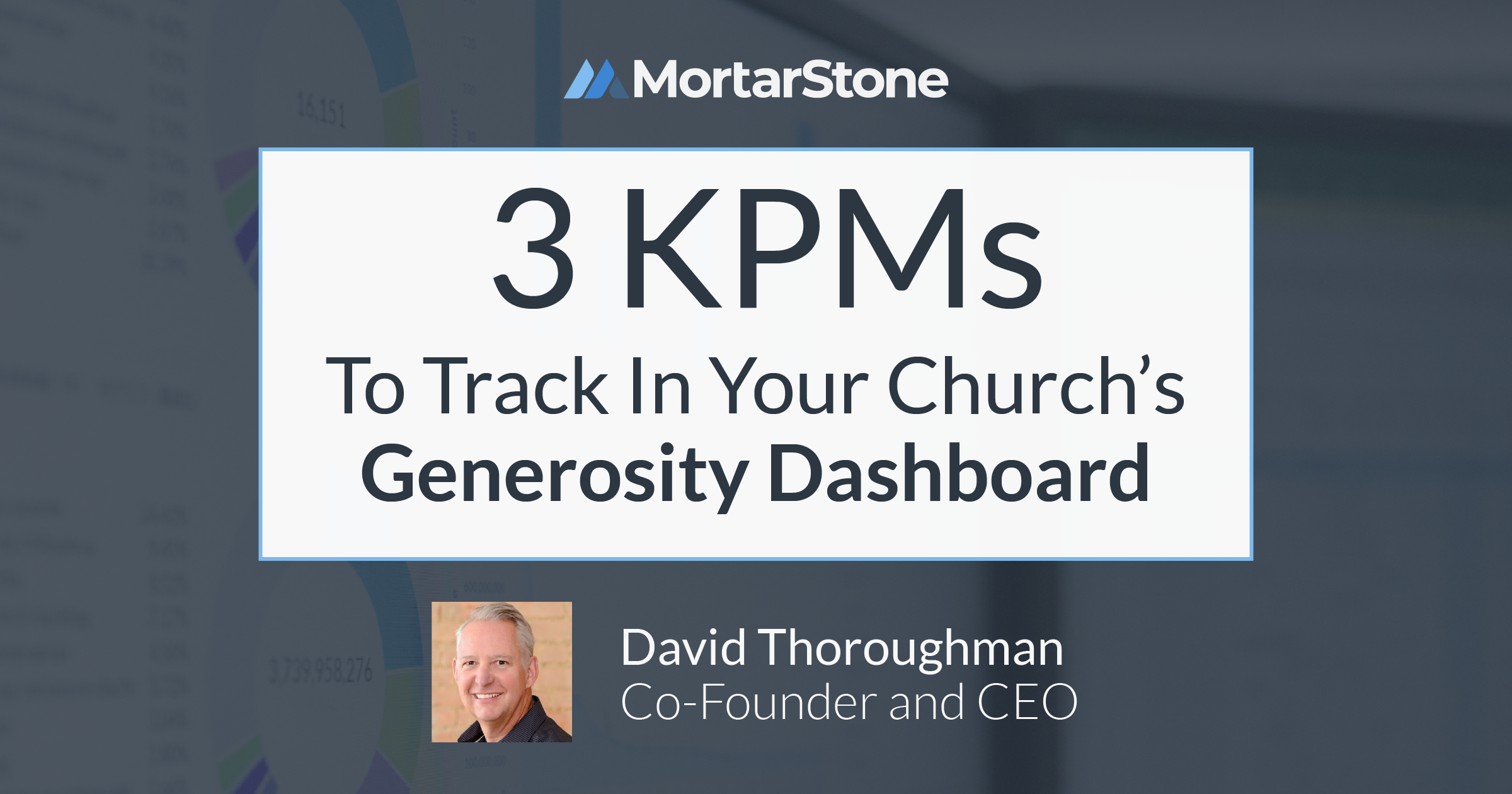When you’re driving a car, you know that the instrument panel of the vehicle is an integral part of the driving experience. As I think about the dashboard of my vehicle, all of the gauges are important, but not all of them are equally emphasized. For example, the speedometer, tachometer, and fuel gauge are more pronounced than the oil and coolant temperature gauges. Again, they are all important, but the pronounced gauges inform both the present and future performance of the car.
As a leader in church generosity software, we are often asked, “What should we be measuring?” By definition, a dashboard is merely a list of Key Performance Metrics (KPMs) that help define, monitor, and measure what is important. Many churches will measure weekend attendance, giving, baptisms, small group participation, and volunteer service. Then, churches will develop intentional pathways that will challenge their attendees to take the next step.
An axiom that we follow at MortarStone is to measure what matters and manage what you measure. Unfortunately, giving is usually reported as a total number without the supporting metrics that inform the total. Including these supporting metrics can allow the church to create strategies that affect change. The result is that church leaders struggle to grow giving because they don’t understand the composition of the total number. Without the best available information, leaders default to pursuing more recurring givers or frequent appeals for people to catch up on their giving or to take the “tithing challenge.” These default gauges may impact behavior, but not impact the heart of the giver.
To develop a comprehensive plan to disciple your people to be generous givers, it’s important to consider three important KPMs.
1. Composition Of Your Giving
The first measurement is the composition of your giving. In MortarStone, the giving composition is most readily viewed in the Giving Bands table. The five bands help visualize your emerging givers, core givers, and top givers in a single table. You can further quantify the composition by using a percentile distribution, a location if multi-site, or age demographic markers to better understand your data. A more technical approach is to evaluate and monitor the Giving Scores of each household, which reveals the recency, frequency, volume, and tenure of each giving unit. Giving Composition and Scores helps you answer questions such as, “Are we too dependent on a small group of givers?” “Are we running the risk of aging out with older givers?” “If attendance and giving are both up, is it sustainable?”
2. Potential Risks
A second important metric evaluates potential risks. The two most significant risk factors are top giver dependency and dependency on people who are over age 60. In our 2023 MortarStone Generosity Report, we cited that these two elements were trending up across all of our software subscribers. Church attendance is another way to monitor risk. According to the research of Dr. Russell James, the number one predictor of giving is church attendance. If your attendance plateaus or decreases, you will likely see a correlation in total giving.
3. Opportunity
The final metric to measure is opportunity. There are several features in MortarStone to help identify untapped potential within your church on the Planning and Capacity page. In this section, MortarStone geocodes the physical address of each household and contrasts their giving with the median household income of their residence according to the US Census Data Block. This data provides insights into what could be versus current reality. A similar tool in MortarStone is the Community Explorer feature, which provides visualization that will compare and contrast givers with not only their median income but the median home value of the Census Block. These important features provide insight into what can be as well as hope for the future financial well-being of the church.
Once you have identified a handful of Key Performance Metrics that you want to measure and manage, consider using workflows that are designed to progress and monitor the effectiveness of your strategies. In many ways, MortarStone is the ‘that was easy’ button for church giving. We automate the reporting, provide managed and automated workflows to communicate, as well as educate and encourage your givers on their generosity journey.
Theologically, stewardship and generosity are spiritual disciplines that require the same level of intentionality and excellence as any special event or weekend experience your church offers, yet if you don’t measure and monitor the activity, you’re missing an opportunity to grow and disciple your givers. Because it is a spiritual discipline, success will require ownership from governance and senior church leadership to create a culture that normalizes generous giving and living.
Operationally, it’s important to retain and grow your giving. But equally, if not more importantly, we have to shift our paradigm to view giving through a spiritual lens. At MortarStone, our observation is that churches will either focus on the money or the people who give the money. Our conviction is that we should focus on the latter.
We realize that you have multiple ministry demands upon your time each day and that it may be difficult to find the margin to tackle this all at once. Great news – you don’t have to undertake this alone! Our team at MortarStone would enjoy the opportunity to meet with you and learn more about your church’s story. If you’re not a software subscriber, consider signing up for the free basic version or request a demo and free trial of our premium version! We would also love to offer a 30-minute consultation with a member of our team to share what we are doing to walk alongside some of the largest, fastest-growing churches in America.
David Thoroughman
Co-Founder & CEO
